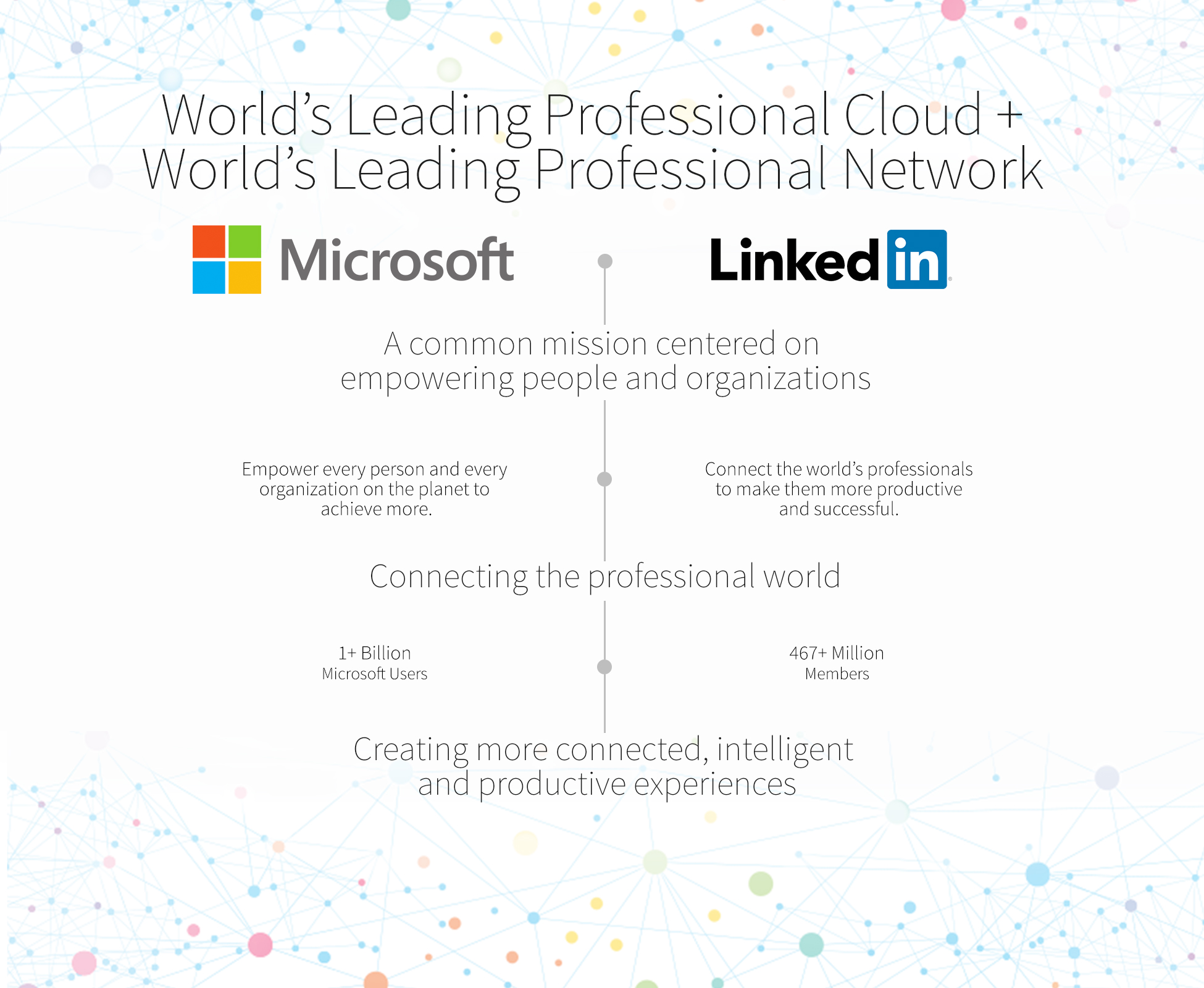
Two weeks ago, news broke of the pending acquisition of the business social network LinkedIn by Microsoft.
This article serves as a follow-up and asks what the purchase means for business professionals and small businesses in particular. In addition to comments from the two company’s CEOs, Small Business Trends has added comments from several small business owners, who shared their thoughts on its implications.
Microsoft-LinkedIn Acquisition Deal Key Elements
To recap, the key elements of the deal are:
- Microsoft will acquire LinkedIn for $196 per share in an all-cash transaction valued at approximately $26.2 billion;
- LinkedIn will retain its distinct brand, culture and independence;
- Jeff Weiner will remain LinkedIn’s CEO and report to Microsoft CEO, Satya Nadella, and join the Senior Leadership Team;
- The transaction is slated to close by the end of 2016.
Microsoft-LinkedIn Share Common Mission
When you read the joint announcement, letters from the two CEOs to their respective staffs or their blog posts adding personal insight, one message comes through loud and clear: Microsoft and LinkedIn share a common mission — empowering people and organizations to be more productive.
For Microsoft, empowerment comes from the use of cloud-based Office 365 and Dynamics CRM software. For LinkedIn, it comes from connecting professionals in a business-based social network.
Put the two together, and you have the potential for a technology platform that fosters office collaboration, sharing and productivity at a scale heretofore unseen.
“Over the past decade, we have moved Microsoft Office from a set of productivity tools to a cloud service across any platform and device,” said Microsoft CEO Nadella in a letter to LinkedIn employees. “This deal is the next step forward for Microsoft Office 365 and Dynamics as we connect them to the world’s largest and most valuable professional network — LinkedIn. I know we’ll invent new ways to help professionals achieve more as we reinvent selling, marketing and talent management business processes.”
Commenting on the reason for the acquisition, LinkedIn CEO Jeff Weiner said in ablog post: “[W]e had virtually identical mission statements. For LinkedIn, it was to connect the world’s professionals to make them more productive and successful, and for Microsoft, it was to empower every individual and organization in the world to achieve more. Essentially, we’re both trying to do the same thing but coming at it from two different places: For LinkedIn, it’s the professional network, and for Microsoft, the professional cloud.”
Benefits of Microsoft-LinkedIn Acquisition – A Peek at the New LinkedIn
Benefits to Microsoft and LinkedIn
Microsoft’s acquisition of LinkedIn hopes to pay each company the following dividends:
- Increased engagement across LinkedIn as well as Office 365 and Dynamics. Microsoft and Linkedin stand to make money through a more seamless access to each other’s customer/member base as well as through individual and organizational subscriptions and targeted advertising.
- Larger Total Addressable Markets (TAM). Microsoft’s and LinkedIn’s markets are both large, bringing in billions per year to each company. Combined, the TAM increases to $315 billion.
- Brings together the professional world. “Today, all the information a professional needs to be successful lives in silos,” said a Microsoft documentoutlining the details of the acquisition. “By connecting the world’s leading professional cloud and professional network, we can create more connect, intelligent and productive experiences.”
Benefits to Users
While the acquisition is beneficial to both Microsoft and LinkedIn, the marriage of the two ecosystems also promises to enhance the working lives of business professionals, in the following ways:
- Increased reach and engagement. Microsoft can use LinkedIn to power the social and identity layers of its ecosystem of over one billion customers. “Think about things like LinkedIn’s graph interwoven throughout Outlook, Calendar, Active Directory, Office, Windows, Skype, Dynamics, Cortana, Bing and more,” said Weiner in the blog post.

- Ubiquitous profiles. Professional profiles will be unified so that the right data surfaces at the right time, when it’s needed, whether that’s in Outlook, Skype, Office or elsewhere.

- Intelligent newsfeed. Microsoft makes a point of saying that, today, information lives in silos causing business professionals to miss relevant news and waste time. With a more intelligent newsfeed that combines industry news with work-related event announcements, that will no longer be the case.
- Predictive digital assistant. Microsoft’s Cortana digital assistant will keep users updated on appointments, events and activities, as well as provide background information on the people they meet — colleagues, coworkers, prospects and others in their network.

- Social sales tool. Sales professionals will move from “siloed” selling to “social” selling thanks to a connection between Dynamics CRM and LinkedIn Sales Navigator, which, according to Microsoft, will “transform the sales cycle with actionable insights and enable the building of deeper relationships, to accelerate sales.”
- Better organizational insights. Leaders can get a better view of their organization’s capabilities and talent through the connected, collaborative environment the merger of the two platforms will foster.
- Enhanced learning opportunities. LinkedIn Learning (Lynda.com) will integrate into Office, enabling users to have a more seamless experience and access to on-demand courses.
- Other benefits. LinkedIn can utilize Microsoft’s field and distribution channels to reach new audiences and more customers. For Microsoft, the platform merger provides the opportunity to increase Bing usage through integration with LinkedIn’s professional search.
What Small Business Owners Have to Say
Small Business Trends asked several small business owners to share their thoughts about the acquisition and its implications. To a person, they were skeptical that it would provide any benefit at all. Here’s what they had to say:
“Nadella talks about serving more newsfeed posts and ‘expert’ help suggestions,” Toby Bloomberg, president, Bloomberg Marketing told Small Business Trends. “I can’t help but wonder if the ‘feed me more algorithm information’ and LinkedIn’s ‘expert suggestions’ will lead to a loss of subscribers. Also, I’m damn curious as to who will be tapped as an ‘expert?’ Those who pay or those who LinkedIn deems an expert by some algorithm.”
“Small businesses don’t use LinkedIn — it’s a personal product not actually built for business use in my opinion,” added Jach Jex, principal at Jex Law Firm, PLLC. “If a business is using LinkedIn to recruit they are usually big enough to not be a ‘small business.’”
“I have not worked with a single small business client that used LinkedIn for much more than creating a business page and making a few random posts (which got no action),” agreed Pamela Hazelton, ecommerce consultant at PamelaHazelton.com
“From a small business owner, I only see that it helps to get my blog posts out there, by using Pulse,” explained Jeff Belonger, social media marketing consultant. “Other than that, I don’t think it does much good. Regarding Microsoft, I feel they had too much money to burn, so they took a gamble.”
“I am interested to see if Microsoft will utilize the big data they have to create a stronger ad program to give small business owners a voice in the ad market,” offered Toby Boyce, Real Estate Broker, Delaware Real Estate. “Other than that, I don’t see it changing much.”
Conclusion
Perhaps Reid Hoffman, LinkedIn co-founder and chairman of the board, should have a talk with these business owners. His enthusiasm, as expressed in the following comments, may be enough to change their mind:
“Think about what happens when we combine our network, our platform of identities with Microsoft’s world-leading set of productivity tools, ranging from Office to Dynamics to Communications to Cloud to Windows to Cortana to Bing,” Hoffman said.

Hoffman continued, “Consider, for example, LinkedIn’s network enabling Active Directory and integrating into Office Productivity. Consider, additionally, connecting LinkedIn identities to Outlook and Skype. Moreover, Microsoft has a great suite of technologies, such as artificial intelligence and Cortana technology, that can add game-changing new capabilities to LinkedIn.”
For Nadella, Weiner and Hoffman, connecting the professional cloud with the world’s largest professional network holds great promise both for Microsoft and LinkedIn. Let’s hope that it contains equal promise for the millions of business professionals the acquisition affects.
[“source-smallbiztrends”]











